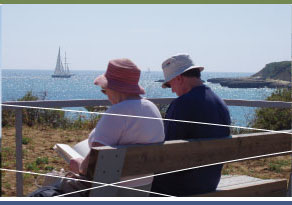The Algarve occupies the extreme south-west of continental Europe. It is approximately 95 miles long and 30 miles wide, and covers about one -twentieth of the total area of Portugal. It is separated from the Alentejo, the next province north, by a low range of mountains , and the River Guadiana forms the natural frontier with Spain to the east.
Perhaps the most attractive feature of the Algarve is simply that it combines so many different attractions - beaches, sunshine, traditional villages, popular coastal resorts, golf courses, sporting facilities, night-life and much more. Whole swathes of the Algarve remain delightfully wild and unexploited, with scores of little bays and coves where you can laze the day away if you wish. Equally you can slip into centuries-old hilltowns to observe the way of life, or stroll along the cliff paths and through orange-scented groves, enjoying the wild flowers and butterflies.
The Algarve divides into three main regions: the coast where most of the intensive tourist development is located; the foothills where most of the agriculture is concentrated: and the almost uninhabited mountains, which support extensive cork oak forests.
The climate is very pleasant all year round, with more than 3,000 hours of sunshine a year. July and August can be very hot, with little or no rainfall. March to June is warm and this is when the countryside is at it's best, a great time for walkers and sightseers. September and October are very warm and pleasant, although there can be a little rainfall. The mountains in the north of the province shelter it from the cold continental air in winter making the climate very mild, but there can be some erratic rainfall from the Atlantic fronts.
Portugal is the world's biggest producer of cork, and much of it is grown in the Algarve and the Alentejo. The traditional almond and fig production, while still important, is in decline, but citrus production is increasing and large areas of the foothills are covered in orange and lemon groves. Tuna, cod and sardine fishing and canning are important, but the industry has not modernised and faces strong competition from Spanish fishermen with more modern fleets.
The main EN 125 road runs the whole length of the Algarve, from Vila Real, near the Spanish border, in the east, right through to Vila de Bispo in the extreme west. Many motorists and holidaymakers use this road to get from A to B, however during the high season it can become quite congested with traffic. The alternative is to take the IN motorway where the traffic usually moves a lot more freely, however it currently runs from the Spanish border just up until Alcantarilha (near Lagoa) where you would then have to feed back onto the EN125.
This website contains lots of information to help you get the best out of the Algarve, and learn about some of the towns, villages and resorts and what they have to offer.







